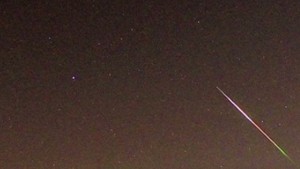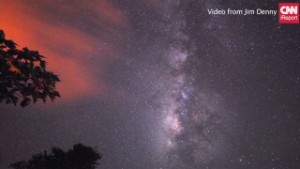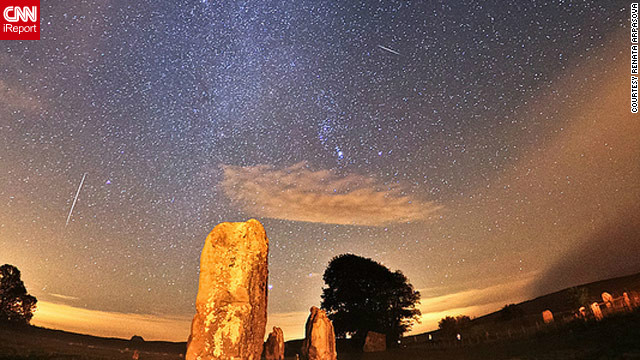| Online: | |
| Visits: | |
| Stories: |
Comet to pass by Earth closely after meteor shower
Saturday, May 24, 2014 8:57
% of readers think this story is Fact. Add your two cents.
 |
| Comet Linear |
By Ben Brumfield
cnn.com
Share your best shots of the meteor shower with CNN iReport, and you could be featured on CNN.
People across the country may be waking up Saturday and rubbing sore necks as they ask themselves if it was worth looking skyward in the middle of the night for hours.
A unique meteor shower glittered the skies over North America, but judging from social media responses, it appeared to do so sparingly in some places, while delivering a few prize goods elsewhere.
But for die-hard star geeks, there will be an Act II, an even bigger treat, as the last part of the shower — a comet — passes by Earth, beginning Saturday evening.
Whatever the verdict, there will probably never be a second chance for the May Camelopardalids meteor shower. Many showers come annually, in October, December, January and April, said NASA meteor observer Bill Cooke.
In August, for example, we will see the return of the spectacular Perseid meteor shower.

Perseid meteor shower lights up the sky

Time-lapse of the Perseid meteor shower
 Capturing the Orionid meteor shower
Capturing the Orionid meteor shower
But the Camelopardalid shower, named for the constellation the shooting stars appeared to fly out of, was a rare gift from the planet Jupiter.
The biggest planet in the solar system bent the meteors’ orbit with its powerful gravitational pull so that they would collide with Earth.
“Next year it will tug the debris field away from the Earth, and we won’t see a meteor shower, so this is kind of a one-shot deal,” Cooke said.
Rare comet pass
The debris field derives from the coming comet, which bears the uninspiring name 209P/LINEAR.
Astronomers have stopped coming up with fancy nomenclature for the hundreds of comets they spot and instead give each new one a number and the name of the project that discovered it.
LINEAR stands for Lincoln Near-Earth Asteroid Research.
Jupiter will fling the comet our way, too, causing it to fly by our planet at a distance of 5 million miles.
“A comfortable distance, which is good,” Cooke said. Its core is 1 to 2 miles wide, and a direct hit to Earth would be disastrous.
Even though 209P/LINEAR passes by every five years while orbiting the sun, this time around it will offer a rare sight to hobby astronomers.
“The comet normally doesn’t pass this close,” Cooke said.
Anyone with a consumer model 3-inch-reflector telescope should be able to see it in the north sky late Wednesday, if the heavens are clear.
Those who want a sneak peek through a more powerful telescope can get it from 6 p.m. ET Saturday via the online observatory service Slooh.
To have 209P/LINEAR’s debris field pass the Earth ahead of its comet is like putting the tail before the dog.
Usually debris fields follow comets just like their tails do. Again, Jupiter was the culprit. It ripped off the debris field and threw it out in front of 209P/LINEAR.
“Jupiter is a big gravitational bully of the solar system,” Cooke said. This particular comet and its field just happen to pass through that planet’s orbit.
After many passes around the solar system, the comet also doesn’t have much of a tail left, so gazers shouldn’t expect to see a long, stunning ribbon trailing it, just a short dash.
Surprise package
Cooke said from the start that the May Camelopardalids could be a star-studded gala or a dud.
NASA couldn’t predict it ahead of time, because the debris field was formed some 200 years ago, when astronomers couldn’t see it, Cooke said. They merely knew that it was coming.
“It’s kind of like being able to predict rain at 11:30 in the morning but not being able to predict a drizzle or a thunder storm.”
Reactions from shooting-star gazers across the country ran the gamut on social media, and judging by some, it did deliver fireworks.
“Izzi and I literally just saw and heard a meteor explode right before our eyes,” .hannaH posted to Twitter
“Just saw a awesomely bright meteor with a blue tail!! #MeteorShower,” Twitter user Carmen said from Chicago.
And it served up some disappointment. Some netizens called it a complete bust.
“Guess anyone who invited someone on a date to watch the ‘meteor shower’ is looking like a pretty big creep right about now,” New Yorker Kevin Depew tweeted.
A tweet from Los Angeles Times reporter Deborah Netburn seemed to sum up neatly reactions to the shower.
“Watched the #Camelopardalids from the Eastern Sierras. Not exactly a meteor storm, but the 3 I saw were so cool. Long streaks across the sky.”
Awe-inspiring photos: ‘Blood moon’ mesmerizes sky gazers
Astronaut tells kid, ‘You’d love it up here’
Source: http://www.ascensionearth2012.org/2014/05/comet-to-pass-by-earth-closely-after.html




